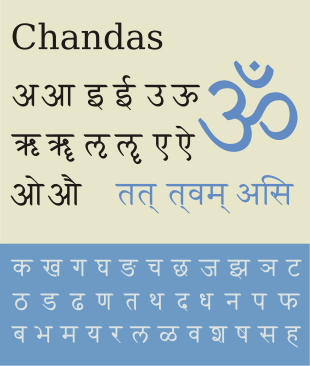Devanagari
Itsura
(Idinirekta mula sa Panitikang Devanagari)
| Devanagari देवनागरी | |
|---|---|
 Devanagari script (vowels top, consonants bottom) in Chandas font. | |
| Uri | Abugida |
| Mga wika | Angika, Awadhi, Bhili, Bhojpuri, Bodo, Chhattisgarhi, Dogri, Haryanvi, Hindi, Kashmiri, Konkani, Magahi, Maithili, Marathi, Mundari, Nepali, Newar, Pali, Rajasthani, Sanskrit, Santali, Sindhi and many more |
| Panahon | Early signs: 1st century CE,[1] modern form: 10th century CE[2][3] |
| Mga magulang na sistema | |
| Mga anak na sistema | Gujarati Moḍī |
| Mga kapatid na sistema | Gurmukhi, Nandinagari |
| ISO 15924 | Deva, 315 |
| Direksyon | Kaliwa-kanan |
| Alyas-Unicode | Devanagari |
| Lawak ng Unicode | U+0900–U+097F Devanagari, U+A8E0–U+A8FF Devanagari Extended, U+1CD0–U+1CFF Vedic Extensions |
| PAALALA: Maaaring naglalaman ang pahinang ito ng mga simbolong pamponetikong IPA. | |
Ang Devanagari ( /ˌdeɪvəˈnɑːɡəri/ DAY-və-NAH-gə-ree; देवनागरी, Padron:IAST3, a compound of "deva" देव and "nāgarī" नागरी; Hindi pronunciation: [d̪eːʋˈnaːɡri]), also called Nagari (Nāgarī, नागरी),[4] ay isang matandang alpabeto na abugida na ginagamit sa Nepal at India. Ito ay isinusulat mula kaliwa hanggang kanan, na mayroong malakas na nais para sa bilog na hugis na may naka-parisukat na awtlayn, at ito ay puwede sa pahigang linya na nakakonekta sa taas ng titik.[5]
Mga sanggunian
[baguhin | baguhin ang wikitext]- ↑ Gazetteer of the Bombay Presidency sa Google Books, Rudradaman’s inscription from 1st through 4th century CE found in Gujarat, India, Stanford University Archives, pages 30–45, particularly Devanagari inscription on Jayadaman's coins pages 33–34
- ↑ Isaac Taylor (1883), History of the Alphabet: Aryan Alphabets, Part 2, Kegan Paul, Trench & Co, p. 333, ISBN 978-0-7661-5847-4,
... In the Kutila this develops into a short horizontal bar, which, in the Devanagari, becomes a continuous horizontal line ... three cardinal inscriptions of this epoch, namely, the Kutila or Bareli inscription of 992, the Chalukya or Kistna inscription of 945, and a Kawi inscription of 919 ... the Kutila inscription is of great importance in Indian epigraphy, not only from its precise date, but from its offering a definite early form of the standard Indian alphabet, the Devanagari ...
{{citation}}: CS1 maint: date auto-translated (link) - ↑ Salomon, Richard (1998). Indian epigraphy: a guide to the study of inscriptions in Sanskrit, Prakrit, and the other Indo-Aryan languages. South Asia research. Oxford: Oxford University Press. pp. 39–41. ISBN 978-0-19-509984-3.
{{cite book}}: CS1 maint: date auto-translated (link) - ↑ Kathleen Kuiper (2010), The Culture of India, New York: The Rosen Publishing Group, ISBN 978-1615301492, page 83
- ↑ Danesh Jain; George Cardona (26 Hulyo 2007). The Indo-Aryan Languages. Routledge. p. 115. ISBN 978-1-135-79710-2.
Nagari has a strong preference for symmetrical shapes, especially squared outlines and right angles [7 lines above the character grid]
{{cite book}}: CS1 maint: date auto-translated (link)
